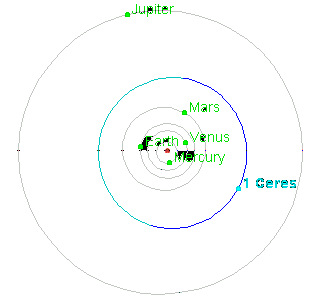1 Ceres
![]()
|
Discoverer |
G. Piazzi 1801. |
|
Diameter (km) |
948 |
|
Mass (kg) |
8,7*10^19 |
|
Rotation period (hrs) |
9.075 |
|
Orbital period (yrs) |
4.60331 |
|
Semimajor axis (AU) |
2.76724 |
|
Orbital eccentricity |
0.07874 |
|
Orbital Inclination (deg) |
10.58385 |
|
Albedo |
0.11 |
|
Type |
G |

| For two centuries it was the largest known rock in the solar
system. The Texas-sized asteroid Ceres, about 930 kilometers across,
was the first asteroid
ever detected. The space rock was identified in 1801 by astronomer Giuseppe
Piazzi, a monk in Sicily and the founding director of the Palermo Astronomical
Observatory. He noted over a few nights a shifting point in the sky that
wasn't one of the planets, their moons or a star. Thus, he discovered
the rock. |
|
 |
After discovering the asteroid, Piazzi was invited to join the Celestial Police, a group of 24 international astronomers looking for what they called "guest planets" between Mars and Jupiter. The Celestial Police noted that the spacing between planets was fairly regular, but that there was a large gap between Mars and Jupiter. Soon other small bodies were discovered in that region (Pallas
in 1802, Juno in 1804 and Vesta
in 1807), so the Celestial Police concluded that not just one, but many
minor planets had to exist in a main asteroid belt. The asteroid
belt probably represents primitive pieces of the solar system that never
managed to accumulate into a genuine planet. |
|
The asteroid
has a very primitive surface, say scientists on NASA's Dawn
mission, which will launch in 2006 and examine Ceres
in 2014. The asteroid,
like a young planet, contains water-bearing minerals, and possibly a
very weak atmosphere and frost. Infrared observations show that the
surface is warm. Recently, Ceres lost its claim to the title of biggest rock in the solar system. In July 2001, a larger object was found in the vast Kuiper belt of asteroids, stretching from 30 to 100 AU This brightest and therefore biggest non-planet space rock, 2001 KX76, could be anywhere from 960 to 1270 kilometers (600 to 790 miles) across. |
|
Images of Ceres |
|
The mid-UV and images of Ceres that shows the Piazzi feature as a darkened spot near the center. Vectors show the direction of the Sun and the image North-East orientation. |
|
|
The mid-UV and the near-UV HST/FOC images of Ceres. Vectors show the direction of the Sun and the image North-East orientation. The values for the relative rotational phase (phi), of each image were calculated assuming a synodic rotational period of P=9.075 hours. The images have been scaled such that they are all normalized to their peak pixel value for optimal contrast and ease of cross-comparisons. The Piazzi feature is near the center of the first mid-UV image (phi = 0.0 deg).
|
|
![]()
Last updated: March 15, 2002.